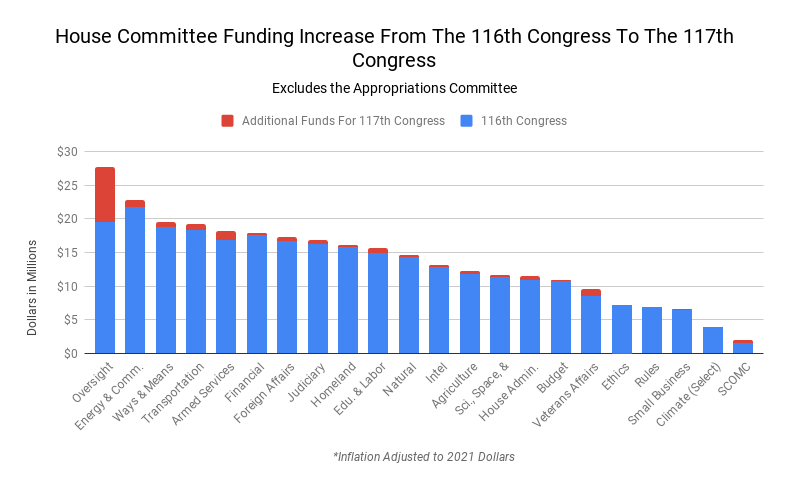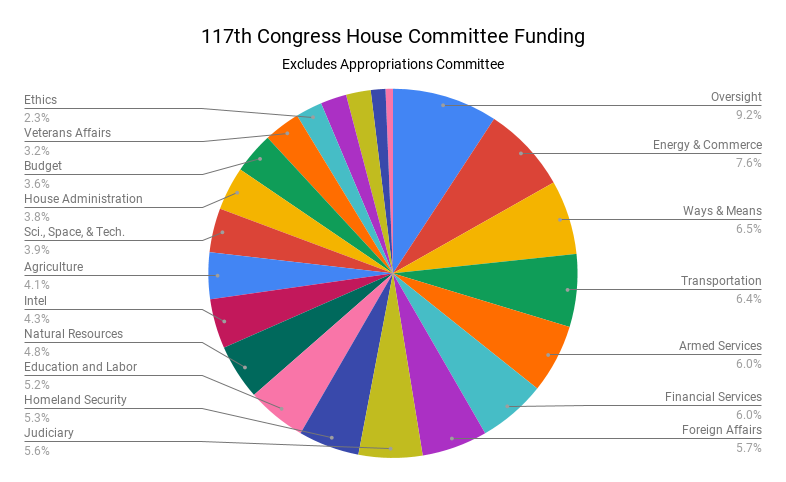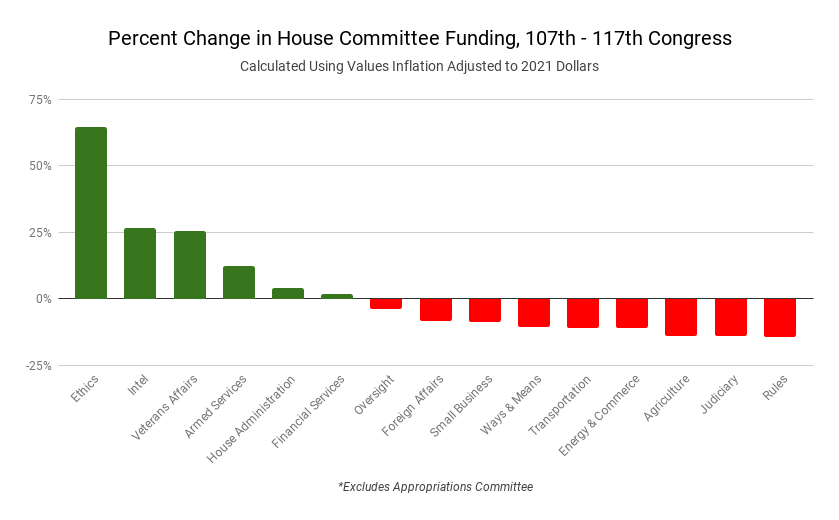Our 2019 and 2020 articles on how House committees are funded have been updated for the 117th Congress.
Committee funding in the House of Representatives is accomplished through a somewhat obscure process. Appropriators on the House Legislative Branch Appropriations Committee set a top dollar amount for the committees — they appropriate the funds — but it is the Committee on House Administration that provides (i.e. allots) the funds to each committee on a biennial basis.
At the beginning of each new Congress, each committee chair and ranking member are given the opportunity to jointly testify before the House Administration Committee and request funds for their committee. In recent years, few committees have testified, and most but not all chairs and ranking members agree upon a common request. This year, most committees introduced their individual committee funding resolutions, then the Committee on House Administration considered a funding resolution (H. Res. 316) on April 14th, and held a markup on April 15th; the resolution passed the House on April 20, 2021.
During the markup, Chair Lofgren noted that each committee would receive an increase in funding of roughly 5% over the last Congress. While this is a notable increase, House committees are still significantly below their funding levels from a decade ago. What does this look like in context? We reviewing decades of funding for House committees, excluding the Appropriations committee — see the un-adjusted committee spending data and the inflation-adjusted committee spending data covering 1995-2021 — and found:
House committees are funded at $301.2 million for the 117th Congress. This represents a $18.3 million or 6.5% increase from the $282.9 million in committee funding last Congress. The average increase per committee is $832,570.
House committee funding is down $72.2 million in inflation adjusted terms from the 111th Congress peak of $373.4 million. Funding this Democratically-controlled Congress also falls short of the $346.7 million in committee funding available during the Republican-controlled 109th Congress.
More than half of House committees experienced funding decreases from the 107th to 117th Congress. Just three committees experienced increases greater than 15% from 2001 to 2021 — Ethics, Intelligence, and Veterans Affairs.
(Please note this analysis excludes funding for the Appropriations Committee, which is the highest funded committee and is funded through a separate mechanism. Also, we are using constant 2021 dollars.)
COMMITTEES FUNDING CHANGES BETWEEN THE 116th AND 117th CONGRESSES
From the 116th Congress to the 117th Congress, committee funding in the House has experienced a median increase of 3.3% per committee, which is almost $470,000 per committee. It is notable that the significant increase in funding for the Oversight Committee likely is not what it seems. We suspect a large portion of the increase is for the newly-created Select Subcommittee on the Coronavirus, which is largely independent of the Oversight committee and may not continue into the next Congress.

FUNDING FOR HOUSE COMMITTEES IN CONTEXT
The House will fund its committees at $301.2 million in the 117th Congress, excluding the Appropriations Committee and the reserve fund.
Total spending on committees is down by $72.2 million in inflation adjusted terms (again excluding the Appropriations Committee) from its peak during the Democratically-controlled 111th Congress; this represents a nearly 20% decrease. Interestingly, funding is also down $45.5 million or 13.1% from the 109th Congress when Republicans controlled both the House and the White House.

FUNDING PER COMMITTEE
Among the committees for which 117th Congress funding data is available, Oversight has the largest budget at $27.8 million, however a good portion of the increase is likely attributable to the Select Select Subcommittee on the Coronavirus. Excluding the Coronavirus Select Subcommittee, House Oversight funding is fairly steady. Coming in at number two is the Energy and Commerce Committee with $22.8 million. Not included, of course, is the Appropriations Committee, which is funded several multiples above Energy and Commerce.
Median House committee funding for the 117th Congress is $13.8 million; overall the pie has shrunk considerably. You can see committee funding levels in the charts below, note the chart does not show funding for the Appropriations Committee, which does not go through the committee allocation process and is generally about 2.5x larger than the next highest funded committee:


CHANGES IN COMMITTEE FUNDING OVER TWO DECADES
As the overall spending pie for committees has shrunk, who has come out ahead and who has lagged behind? We compared committee funding for the 117th Congress against funding levels 20 years ago, in the 107th Congress and found that over that time funding for House committees has fallen a median 11%, which comes out to $1.5 million per committee.
Which committees had the most significant funding increases? The largest dollar increase went to the Intelligence Committee, where funding went up $2.75 million or 26.6%. The largest percentage increase went to the Ethics Committee, where funding increased by just under $2.75 million or 64.4%.
Which committees had the most significant funding decreases? The Budget Committee took the biggest hit in dollar and percentage terms: a $5.6 million or 34% decrease from 2001 to 2021.

WHAT DOES ALL THIS MEAN?
House Democrats could increase funding for committees by 15-20 percent and still be within historical norms for committee spending. Indeed, what the data shows is that the House’s committees have been hollowed out in recent years.
The biggest likely constraints on returning to normal allotment levels is that, while the Legislative branch budget has experienced some small increases in recent years, the bulk of that increase goes to the Capitol Police and the Architect. In other words, with the bulk of investments going towards security or keeping the buildings standing, there is very little funding left to invest in committee work and policy capacity.
This suggests that when Democrats start the Budget process, in which they will decide how much money to make available to the 12 appropriations subcommittees. They should look to increase funds for the Legislative branch by 10%, according to a bipartisan coalition letter sent in February.
A FEW FINAL PROCESS NOTES
First, and not to make things too complicated, but the allotment process (the divvying up of funds among the committees) happens only once, at the start of each Congress, and the allotment resolution covers a two year period. By contrast, the Legislative branch appropriations process, which is what okays the spending of money, happens every year. You can imagine the appropriation as Congress spending money to buy a pie, and the allotment process as cutting up pieces for each committee. The appropriation and allotment process run on different calendars, which can make things confusing.
Second, generally speaking, funds for a committee are further subdivided, with 2/3s available to be spent by the majority and 1/3 by the minority. This isn’t always true, such as for the Ethics committee, and there can be other considerations, but that’s generally how it works. One notable exception is the Modernization Committee, which has a bipartisan staff. In addition, the funds are generally allotted in two segments, for each year of the Congress.
Third, in some Congresses there is a separate reserve fund, just in case a committee overspends.
Fourth, while most committees are allotted funding, Appropriators appropriate funding specifically for the Appropriations Committee in a separate line item.
Finally, the last time there was a select environmental committee, back in the 111th Congress (2009-2010), the committee was allotted $5,109,193 (in inflation-adjusted dollars); by comparison the Select Committee on the Climate Crisis created was allotted $3,865,000 for the 117th Congress.